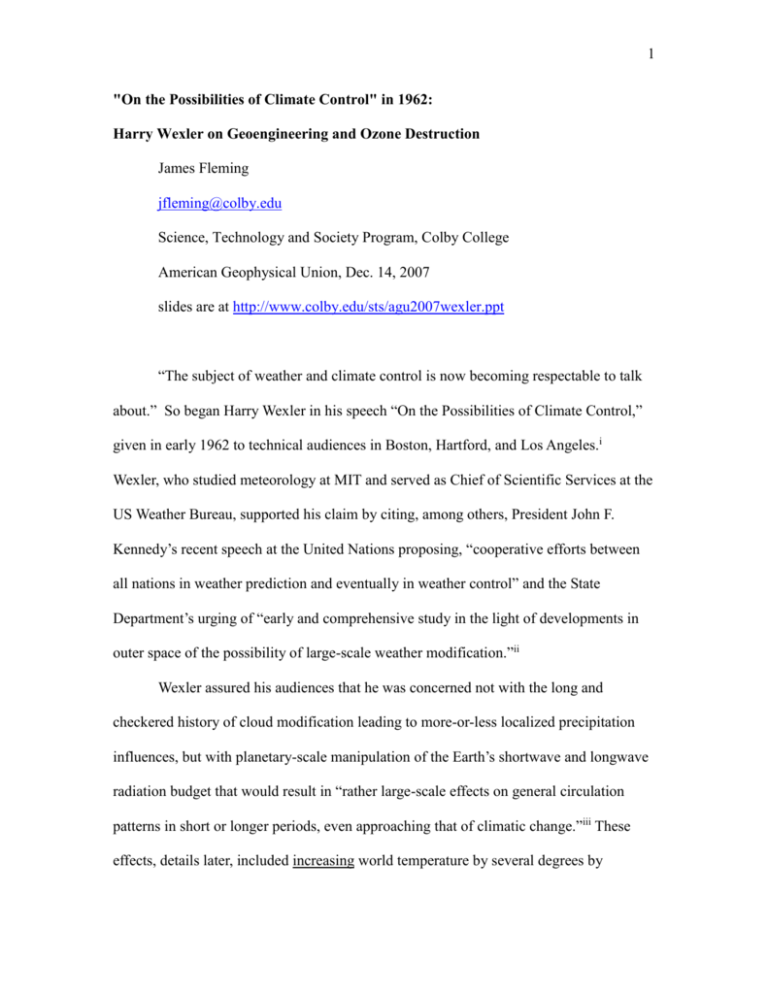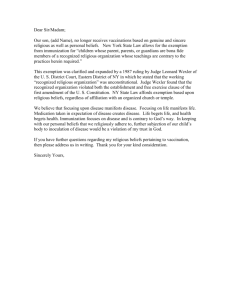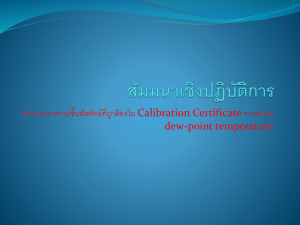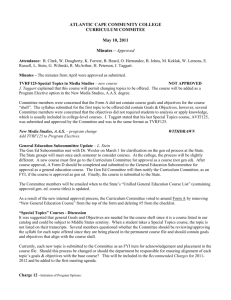Harry Wexler and Oliver Wulf on the possibilities of
advertisement

1 "On the Possibilities of Climate Control" in 1962: Harry Wexler on Geoengineering and Ozone Destruction James Fleming jfleming@colby.edu Science, Technology and Society Program, Colby College American Geophysical Union, Dec. 14, 2007 slides are at http://www.colby.edu/sts/agu2007wexler.ppt “The subject of weather and climate control is now becoming respectable to talk about.” So began Harry Wexler in his speech “On the Possibilities of Climate Control,” given in early 1962 to technical audiences in Boston, Hartford, and Los Angeles.i Wexler, who studied meteorology at MIT and served as Chief of Scientific Services at the US Weather Bureau, supported his claim by citing, among others, President John F. Kennedy’s recent speech at the United Nations proposing, “cooperative efforts between all nations in weather prediction and eventually in weather control” and the State Department’s urging of “early and comprehensive study in the light of developments in outer space of the possibility of large-scale weather modification.”ii Wexler assured his audiences that he was concerned not with the long and checkered history of cloud modification leading to more-or-less localized precipitation influences, but with planetary-scale manipulation of the Earth’s shortwave and longwave radiation budget that would result in “rather large-scale effects on general circulation patterns in short or longer periods, even approaching that of climatic change.”iii These effects, details later, included increasing world temperature by several degrees by 2 detonating up to ten H-bombs in the Arctic Ocean; decreasing world temperature by launching powder into an equatorial orbit to shade the Earth and make it look somewhat like Saturn and its rings; and notably, destroying all stratospheric ozone above the Arctic circle using a relatively small amount of a catalytic agent such as chlorine or bromine. Wexler was interested in both inadvertent climate modification, such as might be created by rocket exhaust gases or other pollution, and purposeful effects, whether peaceful or hostile. So remember it was Wexler, about 50 years ago, who first claimed climate control was “respectable.”iv The stratospheric ozone story is also very significant, given that the received history of ozone depletion dates only to the 1970s and certainly does not include Wexler’s role. Recently, I have been in correspondence with three notable ozone scientists about Wexler’s early work: Nobel Laureates Sherwood Rowland, Paul Crutzen, and National Academy of Sciences President Ralph Cicerone. They are uniformly interested and quite amazed by this story. Let me speak first about Wexler’s credibility. Harry Wexler (1911-1962) was one of the most influential meteorologists of the mid-twentieth century. He was a graduate of Harvard and MIT, a student of C.G. Rossby (slide 2) a proponent of air mass and frontal analysis (slide 3), and Chief of the Scientific Services Division of the U.S. Weather Bureau during an era that saw the introduction of regular radiosonde ascents (slide 4), weather radar (slide 5), atmospheric atomic testing and global fallout tracing (slide 6), scientific sounding rockets (slide 7), and both NWP and GCMs (slide 8) Here is Wexler with Von Neumann, Charney, and others associated with the Institute for Advanced Study meteorology program at Princeton. Wexler was a pioneer in satellite meteorology 3 (slide 9). He was in charge of the TIROS program and helped Verner Suomi fly his first heat budget experiment on Explorer 7. Wexler was head of US Antarctic programs for the International Geophysical Year (slide 10), established the Mauna Loa Observatory and supported Dave Keeling’s measurements of CO2 (slide 11), wrote on peaceful use of satellites and weather control for JFK (slides 12, 13), and planned the World Weather Watch (slide 14) which became a reality in 1963, the year after his sudden death at the age of 51. Wexler was clearly on top of his science, a leader in new techniques and technologies, and a respected international figure. Wexler on the possibilities of ozone depletion and climate control In his 1962 speeches on climate control,v Wexler discussed increasing pollution both from industry and from the use of sounding rockets, and recent developments in science, including computing and satellites, that led him to believe that manipulating and controlling large-scale phenomena in the atmosphere were distinct possibilities. Wexler mentioned rising carbon dioxide emissions as an example and cited a 1961 study by the Geophysics Corporation of America on modification of the Earth’s upper atmosphere by rockets (slide 15). At the birth of modern computing in 1945, Dr. V.K. Zworykin, then at the RCA Laboratories in Princeton imagined a perfectly accurate machine that would predict the immediate future state of the atmosphere and identify the precise time and location of leverage points or sensitive conditions so that a paramilitary rapid deployment force might be sent out into the field to intervene in the weather as it happens—literally to 4 pour oil on troubled ocean waters or even set fires or detonate bombs to disrupt storms before they formed, deflect them from populated areas, and otherwise control the weather. According to Zworykin: The eventual goal to be attained is the international organization of means to study weather phenomena as global phenomena and to channel the world’s weather, as far as possible, in such a way as to minimize the damage from catastrophic disturbances, and otherwise to benefit the world to the greatest extent by improved climatic conditions where possible. John von Neumann, the multi-talented mathematician extraordinaire at the Institute for Advanced Study agreed, writing, “All stable processes we shall predict. All unstable processes we shall control.” The noted oceanographer Athelstan Spilhaus, then a U.S. Army major, wrote to Zworykin, “In weather control, meteorology has a new goal worthy of its greatest efforts.” All this was cited by Wexler in his speech. While acknowledging growing technical prowess and scientific capabilities, including 100 MT bombs and earth-orbiting satellites, Wexler noted “a growing anxiety” in the public pronouncements that “Man, in applying his growing energies and facilities against the power of the winds and storms, may do so with more enthusiasm than knowledge and so cause more harm than good.”vi Wexler did not intend to cover all possibilities “but just a few… limited primarily to interferences with the Earth’s radiative balance on a rather large scale [original emphasis]…. I shall discuss in a purely hypothetical framework those atmospheric influences that man might attempt deliberately to exert and also those which he may now 5 be performing or will soon be performing, perhaps in ignorance of its consequences. We are in weather control now whether we know it or not.” “We have for decades been releasing huge quantities of carbon dioxide and other gases and particles to the lower atmosphere. It is recognized that this atmospheric pollution may have serious effect not only on health but on global radiation or heat balance which is the cause of our present pattern of climate and weather.”vii Then Wexler showed some 20 technical slides of the atmosphere’s radiative heat budget and discussed means of manipulating it. He concluded with this figure (slide 16) a grand summary of various techniques. The table lists a means of (a) increasing global temperature by 1.7 C by injecting a cloud of ice crystals into the polar atmosphere by detonating 10 H-bombs in the Arctic Ocean—the subject of his 1958 article in Science magazine; viii (b) lowering global temperature by 1.2 C by launching a ring of dust particles into equatorial orbit, a modification of an earlier Russian proposal to warm the Arctic, and (c) destroying all stratospheric ozone, raising the tropopause, and cooling the stratosphere by up to 80 oC by an injection of a catalytic agent such as Chlorine or Bromine. The revisions in pencil show his newly lowered estimates of the amounts of material required. For example, that 0.1 MT of bromine would destroy all ozone in Polar regions and 0.4 MT would be needed near the equator. Wexler was concerned (slide 17) that inadvertent damage to the ozone layer might occur if increased rocket exhaust polluted the stratosphere. He was also concerned that future near-space experiments could go awry, citing Operation Argus (nuclear blasts 6 in near space, 1958), Project West Ford (a ring of small copper dipole antennas in orbit, 1961), and Project Highwater (ice crystals injected into the ionosphere, 1962) as recent significant interventions with unknown risks. Purposeful damage was also not out of the question. In 1934 the noted geophysicist Sydney Chapman had proposed making a temporary “hole in the ozone layer” using a yet-to-be-identified catalytic “deozonizer.” According to Chapman, a small hole cut at a remote location might enable astronomers to make observations at ultra-violet wavelengths where radiation was otherwise absorbed by ozone. Much more sinister and relevant to the Cold War was possible military interest in waging geophysical warfare by attacking the ozone layer over a rival nation. Seeking advice on how to cut a “hole” in the ozone layer, Wexler turned to chemist Oliver Wulf at Caltech who suggested that chlorine or bromine atoms might act in a catalytic cycle with atomic oxygen to destroy thousands of ozone molecules. In a hand-written note composed in January 1962 Wexler scrawled the following (slide 18): “UV decomposes O3 --> O in presence of halogen like Br. O --> O2 recombines and so prevents more O3 from forming; and (slide 19) “Br2 --> 2 Br in sunlight destroys O3 --> O2 + BrO.” These are essentially the basis of the modern ozone depleting chemical reactions. Here (slide 20) is Wexler’s computation, using Manabe and Möller’s model of an 80 oC stratospheric cooling with no ozone layer. Wexler concluded that he was not making proposals to intervene, but was involved in studying the basic equations and engineering aspects of general circulation research, including the natural behavior of the atmosphere, unintentional effects, and aspects of particular interest to the DoD. 7 A final example of documentation in the archives—a sort of ozone depletion Rosetta stone—is Wexler’s rough note of 1962 that links Chapman 1934, Wulf, rocket fuel and ozone destroying reactions triggered by chorine and bromine as catalysts (slide 21). Under normal circumstances, Wexler would have prepared his lecture for publication, but he was cut down by a sudden heart attack in August 1962. The documents relating to his career, especially his remarkable work on ozone depletion and climate control headed into the archives, probably not to be seen and certainly not to be re-evaluated until today. The well-known and well-documented Supersonic Transport (SST) and ozone depletion issues developed about a decade later. The idea that bromine and other halogens could destroy stratospheric ozone was published in 1974, while CFC production expanded rapidly and dramatically between 1962 and its peak in 1974. Had Wexler lived to publish his ideas, they would certainly have been noticed and could have led to a different outcome and perhaps an earlier coordinated response to the issue of stratospheric ozone depletion. And the issue of a technological fix for climate change—geoengineering— remains very much alive today. Conclusion It is clear that Harry Wexler was well-qualified to speak authoritatively about the otherwise “nebulous” subjects of climate, climate change, and climate control. He was on all the scientific panels and advisory boards, had access to and helped collect global 8 climate data, understood the theoretical issues and their complexity, and promoted and advanced the latest technologies, most relevantly general circulation modeling and satellite heat budget measurements. He warned then, and we might wisely conclude today, that (slide 22): “[Climate control] can best be classified as ‘interesting hypothetical exercises’ until the consequences of tampering with large scale atmospheric events can be assessed in advance. Most such schemes that have been advanced would require colossal engineering feats and contain the inherent risk of irremediable harm to our planet or side effects counterbalancing the possible short-term benefits.”ix Wexler’s prescient work between 1958 and 1962 “On the Possibilities of Climate Control” reminds us that we are not the first generation to be involved with or concerned about geoengineering. 9 Notes Harry Wexler, “On the Possibilities of Climate Control,” Boston Chapter of the American Meteorological Society, Jan 9, 1962; Traveler’s Research Corporation, Hartford, CT, Jan. 11, 1962; and UCLA Department of Meteorology, [as Regent’s Lecturer in Meteorology] Feb. 28, 1962. Notes in Manuscript Division, Library of Congress, Wexler Papers, Box 18, Speeches and Lectures, 1962. ii John F. Kennedy, Address in New York City Before the General Assembly of the United Nations. September 25th, 1961. See also Kennedy’s press conference of March 1, 1961 and US Resolution on Peaceful Uses of Outer Space. iii On weather control see Fleming 2004 and 2006. iv Fleming 2007. v Wexler box 18, “On the possibilities of climate control,” Draft, Jan. 8, 1962. vi Wexler Box 18, “Further justification for the General Circulation Research Request for FY 63,” Draft, Feb. 9, 1962. vii Wexler, “Further justification.” viii H. Wexler, “Modifying Weather on a Large Scale,” Science, n.s. 128 (Oct. 31, 1958): 1059-1063. “When serious proposals for large-scale weather modification are advanced, as they inevitably will be, the full resources of general-circulation knowledge and computational meteorology must be brought to bear in predicting the results so as to avoid the unhappy situation of the cure being worse than the ailment.” n. 17. N. N. Zubov, V. Tsentre Arktiki (Moscow, 1948), a translation of E. Hope, Arctic Ice and the Warming of the Arctic (Ottawa, 1950), chap. 6, 7. R. A. McCormick of the U.S. Weather Bureau has computed that it would take a minimum of 100 years to melt the Arctic ice pack by pumping water across the Bering Straits, as has been suggested by A. B. Markin of the Moscow Institute of Power. An ice cloud [generated by H-Bombs] would require less than 10 years. ix Harry Wexler 1962, UN Symposium, Box 14. i






